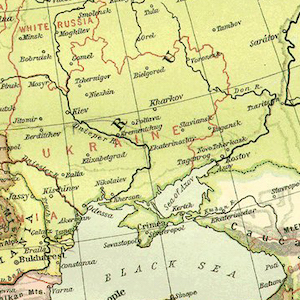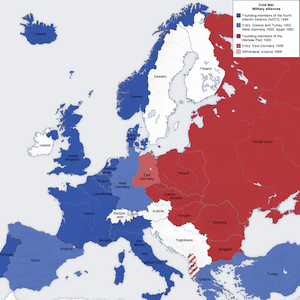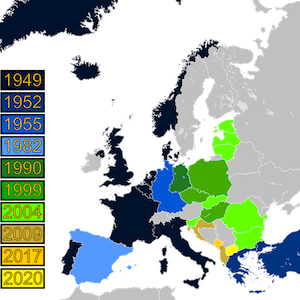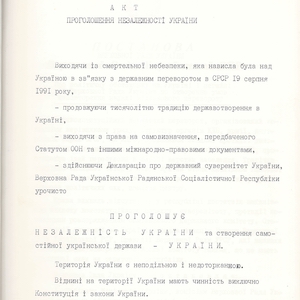Long Teaching Module: Border Changes of the Soviet Union
Overview
Border changes have been a central part of 20th century European history. This lesson will examine a few key maps and documents that explore the creation, expansion, and dissolution of the Soviet Union. The Soviet Union arose from the First World War, was expanded by the Second World War, and was destroyed by the Cold War. With its collapse, 15 new independent states formed across the territories of Eastern Europe and Central Asia. This lesson will explain some of the context for the major border changes that affected the Soviet Union as well as the roots and enduring legacy of its collapse. Using maps and primary source documents, it directs readers to think about different perspectives about border changes.
Essay
Border changes and warfare were two key aspects of everyday life for much of the European continent in the 20th century. One place that saw profound transformation, both in terms of society and borders, was Eastern Europe. The Russian Empire entered the First World War in July 1914 as a result of its alliance with Serbia. Tsarist Russian forces warred for over two and a half years before the home front erupted into revolution amidst failing military campaigns, heavy loss of life, inflation, and food shortages. In February 1917, Tsar Nicholas II abdicated after protests swelled to riots and a revolution. A Provisional Government attempted to stabilize the home front as well as the military situation, but it failed to do so. A second revolution in October 1917 brought the Bolsheviks, under the leadership of Vladimir Lenin, to power in Petrograd (present-day St. Petersburg) and Moscow.
The Bolshevik government worked on quickly ending Russia’s involvement in the First World War. Although unpopular, the Bolshevik government signed a separate treaty with the German, Austro-Hungarian, and Ottoman Empires in March 1918 to withdraw from the war and prevent losing any more territory. By signing the Treaty of Brest-Litovsk, the Bolshevik government defaulted on its commitments to the Entente Powers and lost control of nearly all of Ukraine and the Baltic republics of Estonia, Latvia, and Lithuania. These territories became independent states in the post-war restructuring of Eastern European borders. Some of these border changes were short lived, though.
Following a successful revolution in Petrograd and Moscow, the Bolsheviks had to fight to gain control of other territories of the former Russian empire and to create a new state. The subsequent Russian Civil War lasted from 1917 to 1922. During this Civil War, Bolshevik forces recaptured part of the territory that they had ceded to Germany under the Treaty of Brest-Litovsk. In December 1922, the Russian, Ukrainian, Byelorussian, and Transcaucasian Soviet Socialist Republics signed the Declaration on the Creation of the Union of Soviet Socialist Republics, which formed the constitutional basis for the establishment of the Union of Soviet Socialist Republics (USSR, or Soviet Union). The Soviet Union continued to grow and by 1939 the Armenian, Azeri, Belorussian, Georgian, Kazakh, Kyrgyz, Russian, Tajik, Turkmen, Ukrainian, and Uzbek Soviet Socialist Republics comprised the USSR.
As was the case with the First World War, the Second World War ushered in a series of border changes in Europe and Eurasia. The Soviet Union acquired new territories in the conflict, which became official republics of the Soviet Union: the Estonia, Latvia, Lithuanian, and Moldovan Soviet Socialist Republics.
While the Soviet Union joined forces with the United States, the United Kingdom, and France to defeat Nazi Germany, tensions quickly rose towards the end of the war over the future of Europe. The massive destruction of the Second World War shaped how Soviet officials approached the European post-war order. The Great Patriotic War, as it was known in the USSR and is known to this day in Russia, caused tremendous damage to the Soviet Union. The USSR lost about 27 million citizens in the conflict. The Soviet economy was also greatly damaged by the war. The USSR lost one quarter of its total physical assets during the war. Hundreds and thousands of cities, villages, schools, factories, and farms lay in complete ruin. The human and economic costs of the war led to disagreements between Soviet and other Allied officials about the future course of Europe. Joseph Stalin, the leader of the USSR, wanted to ensure that Germany could never again attack.
As Soviet and Allied diplomats failed to reach an agreement over the future of Europe, Soviet officials moved towards a new alignment for post-war Europe as a means of security. Territories liberated by the Soviet Red Army as it moved to Berlin to defeat the Nazis essentially remained under Soviet control as satellite states of the USSR. Communist regimes ruled these states, which were allied with the Soviet Union. In part, Soviet officials wished for these regions to remain under their control as buffer zones so that any conflict with Western powers would not be fought on Soviet soil. As tensions between the USSR and Western powers rose, a new conflict emerged, the Cold War. The Western allies formed a military collective security alliance in 1949, the North Atlantic Treaty Organization (NATO). After West Germany joined NATO in 1955, the Soviet Union and its Eastern bloc allies of Bulgaria, Czechoslovakia, East Germany, Hungary, Poland, and Romania formed their own military alliance, known as the Warsaw Pact.
The Warsaw Pact crumbled with the collapse of communism and the Revolutions of 1989. In the 1970s, the Soviet economy stagnated and became increasingly weakened by its massive defense budget. In 1985, Mikhail Gorbachev became the General Secretary of the Communist Party of the Soviet Union. He enacted major policies hoping to reform and improve the Soviet Union. His two major policies of glasnost’ (openness) and perestroika (economic restructuring) had the unintended consequence of the collapse of the Soviet Union as admissions of problems with the system and the ability to criticize it led Soviet citizens and politicians to looks for new paths forward. Gorbachev also promised that the Soviet Union would not interfere in the actions of the satellite nations, where anti-communist dissident movements increasingly grew in popularity and strength. In 1989, communist regimes fell in Poland, East Germany, Czechoslovakia, Hungary, Bulgaria, and Romania.
By 1991, Soviet collapse was imminent. The costs of the Cold War overburdened the Soviet economy, which continued to falter. With the increasing freedom of speech that glasnost’ brought to the Soviet Union, Soviet citizens lost confidence in the state to lead society. Nationalist movements across the USSR also arose as Gorbachev’s new openness allowed them to be elected to leadership positions. In 1991, the popularly elected governments of Estonia, Latvia, and Lithuania, the last states to join the USSR, declared their independence from the Soviet Union to overwhelming support. Hardline communist leaders and military elites tried to overthrow Gorbachev in August 1991 but failed.
The Soviet government recognized the secession of the Baltic states in September 1991. In early December 1991, leaders of Russia, Ukraine, and Belarus met in Alma-Ata, Kazakhstan to sign the Belovezh Accords, which mutually recognized the independence of these states and created the Commonwealth of Independent States (CIS), an organization meant to facilitate close ties between former Soviet states.
By December 21, 1991, every Soviet state had declared independence and all but the Baltics and Georgia joined the CIS. On December 25, 1991, Gorbachev resigned and turned his presidential powers over to Boris Yeltsin, the president of the Russian Federation. On December 26, 1991, the Supreme Soviet of the Soviet Republics formally dissolved the Soviet Union. In its place were fifteen independent states: Armenia, Azerbaijan, Belarus, Estonia, Georgia, Kazakhstan, Kyrgyzstan, Latvia, Lithuania, Moldova, Russia, Tajikistan, Turkmenistan, Ukraine, and Uzbekistan.
Although relatively bloodless, the post-Soviet transition has not been an easy one. Russia entered a period of economic chaos and instability, from which it only emerged under the leadership of Vladimir Putin. Some states such as Belarus, Azerbaijan, and Armenia remain close to Russia, while others have moved as far away from Russian influence as possible and have attempted to secure other means of security. The Baltic States of Estonia, Latvia, and Lithuania have joined NATO, for example. Other satellite states that formerly belonged to the Warsaw Pact, such as Poland, Hungary, and Romania, have also joined NATO. From the Russian perspective, this is increasingly worrying as its leadership interprets this as an encroachment on what has historically been Russia’s sphere of influence. The reorganization of post-Soviet alliances and borders have resulted in numerous tensions and conflicts in Eastern Europe and will likely remain a source of conflict for the former Soviet states.
Primary Sources
Credits
Susan Grunewald is an Assistant Professor of 20th Century European History at Louisiana State University. She recently completed a three-year term as the Digital History Postdoctoral Associate at the University of Pittsburgh World History Center. Her research focuses on German prisoners of war in the Soviet Union during and after World War II. She frequently utilizes digital humanities methods such as GIS mapping and text analysis in her research. You can find her on Twitter: @SusanGrunewald1



